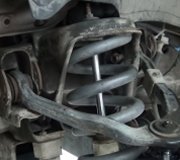Nope. You are describing a wheel that is moving forward. GM vehicles have been well-known since the mid 1970's to have a characteristic with their spindles that makes the tires turn in unusual patterns. We used to see this when turning sharp one way, then backing up. The two tires would argue over where to steer, and the sidewall on one would flex as far as possible, then the tread would squirt over and that corner of the car would drop down. This only happened when turning fully in one direction. When the garage doors were open in the summer, we could always tell when someone was driving a GM car behind us into the shop by the sound of the scrubbing tires.
That same characteristic makes the wheel and tire turn on a circle, so to speak, instead of turning on a dot on the road surface. As the left wheel turns to the right, it moves forward, and as it turns to the left, it moves rearward. The openings in the fenders are large enough to accommodate that. Where it causes a problem is when people put on aftermarket wheels that are wider or have a deeper offset. That can move the outer edge of the tread far enough in sharp turns for it to hit the fender.
Friday, April 6th, 2018 AT 7:30 PM


